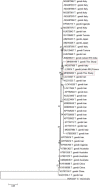Molecular Genotyping of Toxoplasma gondii in Sheep Aborted Fetuses Reveals Predominance of Type I Infection in Southwest of Iran
- PMID: 33082802
- PMCID: PMC7548476
- DOI: 10.18502/ijpa.v15i3.4202
Molecular Genotyping of Toxoplasma gondii in Sheep Aborted Fetuses Reveals Predominance of Type I Infection in Southwest of Iran
Abstract
Background: We aimed to detect Toxoplasma gondii in ovine aborted fetuses and evaluate its genetic variations in the southwest of Iran.
Methods: This cross-sectional study was performed on 100 aborted ovine fetuses collected from the different region of Kohgiluyeh and Boyer-Ahmad Province, Iran, in lambing season during 2017 and 2018. DNA was extracted from the brain samples of all of the aborted fetuses and PCR amplified, targeting a 529 bp repetitive element gene of T. gondii. Moreover, to find out the heterogeneity of the positive samples, PCR-DNA amplification of the two main genetic markers, B1 and GRA6, of T. gondii were performed. Nucleotide sequencing and phylogenetic analysis were performed, using the BLAST program and MEGA-X software.
Results: The 529 bp gene of T. gondii was detected in 2 out of 100 (2%) of the ovine aborted samples. The sequences analysis of GRA6 and B1 genes revealed that both isolates from the aborted fetuses of sheep belonged to type I of T. gondii. Intra-divergence was more seen in GRA6 gene whereas less divergence was observed in B1 gene.
Conclusion: Congenital infection with Type I of T. gondii during the neonatal period is associated with abortion in ovine. Evaluation of more aborted samples from broader geographical areas is needed to elucidate the molecular epidemiology and also the genotypes of T. gondii associated with abortion.
Keywords: Iran; Ovine aborted fetuses; Sequence analysis; Toxoplasma gondii.
Copyright© Iranian Society of Parasitology & Tehran University of Medical Sciences.
Conflict of interest statement
Conflict of interest The authors declare that there is no conflict of interest.
Figures




Similar articles
-
Serological and molecular survey of Toxoplasma Gondii in aborted livestock fetuses from Northeast Iran.BMC Res Notes. 2024 Oct 3;17(1):290. doi: 10.1186/s13104-024-06915-4. BMC Res Notes. 2024. PMID: 39363333 Free PMC article.
-
Molecular genotyping and serological evaluation of Toxoplasma gondii in mothers and their spontaneous aborted fetuses in Southwest of Iran.Comp Immunol Microbiol Infect Dis. 2019 Oct;66:101342. doi: 10.1016/j.cimid.2019.101342. Epub 2019 Jul 30. Comp Immunol Microbiol Infect Dis. 2019. PMID: 31437675
-
Isolation and Genotyping of Toxoplasma gondii Strains in Ovine Aborted Fetuses in Khorasan Razavi Province, Iran.Korean J Parasitol. 2016 Feb;54(1):15-20. doi: 10.3347/kjp.2016.54.1.15. Epub 2016 Feb 26. Korean J Parasitol. 2016. PMID: 26951974 Free PMC article.
-
Toxoplasma gondii in Aborted Fetuses of Sheep in Ardebil Area, North-West of Iran.Iran J Parasitol. 2019 Jul-Sep;14(3):430-435. Iran J Parasitol. 2019. PMID: 31673261 Free PMC article.
-
Global prevalence of Toxoplasma gondii infection in the aborted fetuses and ruminants that had an abortion: A systematic review and meta-analysis.Vet Parasitol. 2021 Feb;290:109370. doi: 10.1016/j.vetpar.2021.109370. Epub 2021 Jan 27. Vet Parasitol. 2021. PMID: 33550003
Cited by
-
Toxoplasma gondii in Slaughtered Sheep in High- and Low-Humidity Regions in the South of Iran: Molecular Prevalence and Genotype Identification.Vet Med Int. 2021 Jul 5;2021:5576771. doi: 10.1155/2021/5576771. eCollection 2021. Vet Med Int. 2021. PMID: 34326981 Free PMC article.
-
Prophylactic Effect of Microwave Radiation on Toxoplasma gondii Tachyzoites of RH Strain: A Method for Partial Immunization in BALB/c Mice.J Parasitol Res. 2025 May 27;2025:1666892. doi: 10.1155/japr/1666892. eCollection 2025. J Parasitol Res. 2025. PMID: 40463489 Free PMC article.
-
Serological and molecular survey of Toxoplasma Gondii in aborted livestock fetuses from Northeast Iran.BMC Res Notes. 2024 Oct 3;17(1):290. doi: 10.1186/s13104-024-06915-4. BMC Res Notes. 2024. PMID: 39363333 Free PMC article.
-
Molecular Detection of Toxoplasma gondii Oocytes in Soil Samples from Guilan Province, Northern Iran.Iran J Public Health. 2024 Mar;53(3):654-662. doi: 10.18502/ijph.v53i3.15147. Iran J Public Health. 2024. PMID: 38919312 Free PMC article.
-
Serological and molecular survey of Toxoplasma gondii infection and associated risk factors in urban cats in Kunming, Southwest China.Front Vet Sci. 2024 Jun 18;11:1393236. doi: 10.3389/fvets.2024.1393236. eCollection 2024. Front Vet Sci. 2024. PMID: 38957802 Free PMC article.
References
-
- Dubey J. Toxoplasmosis in sheep—the last 20 years. Vet Parasitol. 2009;163(1–2):1–14. - PubMed
-
- Asgari Q, Sarnevesht J, Kalantari M, et al. Molecular survey of Toxoplasma infection in sheep and goat from Fars province, Southern Iran. Trop Anim Health Prod. 2011;43(2):389–92. - PubMed
-
- Oliveira FCd, Oliveira PAd, Cunha Filho NAd, et al. The incidence and productive significance of ovine toxoplasmosis in Southern Brazil. Ciência Rural. 2016;46(9): 1618–1621.
LinkOut - more resources
Full Text Sources
Research Materials
